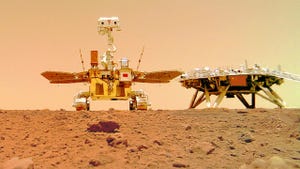
NASA Images Confirm China's Mars Rover Hasn't Moved in Months - CNET
This story is part of Welcome to Mars, our series exploring the red planet.
Questions have been swirling around the status of China’s charismatic Zhurong Mars rover. The solar-powered rover went into a hibernation state in May 2022 thanks to a dust storm and cold conditions. A sequence of images captured by NASA’s Mars Reconnaissance Orbiter shows the rover hasn’t moved since at least early September 2022.
The HiRise team at the University of Arizona shared three different views of Zhurong on Tuesday. Zhurong looks like a bluish dot to MRO’s HiRise camera.
A series of three NASA MRO images from orbit show the bluish dot of the Zhurong rover. The first image is from March 2022, the second from September 2022 and the third from February 2023.
NASA/JPL-Caltech/UArizona
Landscape features like dunes and a crater appear in the surrounding area of Mars’ Utopia Planitia. The first image is from March 11, 2022, the second from Sept. 8, 2022 and the most recent from Feb. 7, 2023. The rover is in the same place in the last two images, which doesn’t bode well for its prospects.
The China National Space Administration is famously secretive about its work, so official announcements about missions can be few and far between. CNSA hasn’t released any current updates on Zhurong.
Zhurong arrived on Mars in May 2021 as part of the Tianwen-1 mission, which included a lander and an orbiter. China became only the second country to successfully operate a rover on Mars, putting it in good company with NASA’s rovers.
Martian conditions can be tough for robotic explorers, especially ones that rely on solar power. NASA’s InSight lander and Opportunity rover both reached the ends of their missions after dust caked their panels. It’s possible Zhurong has experienced a similar fate. Whatever happens, the rover still completed its main mission objectives and handily outlasted its original three-month life expectancy, cementing its legacy in the history of space exploration.


